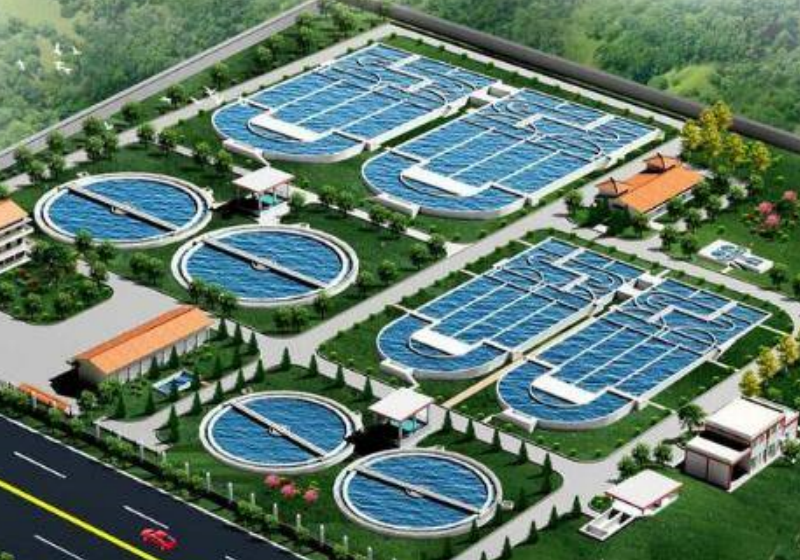Operation of Secondary Sedimentation Tank
In wastewater treatment process,after biological treatment, the sewage must enter the secondary sedimentation tank for sludge-water separation, and the clarified qualified treated water can be discharged. At the same time, a certain concentration of returned sludge or a certain amount of treated water must be provided for biological treatment facilities. Therefore, the working performance of the secondary sedimentation tank has a direct relationship with the operating effect of the activated sludge system.
What are the basic requirements for setting up a secondary sedimentation tank?
1.The hydraulic load is generally 0.5-1.8m./ (m2 · h). In industrial wastewater treatment solution, the proportion of organic matters in activated sludge is relatively large, and the SVI of mixed liquid in aeration tank is relatively high. The secondary sedimentation tank matched with it should adopt low surface hydraulic load.
2.In order to ensure that the sludge can be thickened enough in the secondary sedimentation tank to supply the return sludge with the required concentration in the aeration tank, the solid surface load of the secondary sedimentation tank is 1.50kg/(m2 · d), and the solid surface load of the inclined tube (plate) secondary sedimentation tank can be expanded to 192kg/(m ²· d)。
3.The water depth at the side of the secondary sedimentation tank should be 2.5~4m, and the specific value is related to the size of the tank. The larger the diameter of the secondary sedimentation tank, the greater the water depth at the side of the tank, otherwise the hydraulic efficiency of the secondary sedimentation tank will be reduced and the effective volume will be reduced.
For secondary sedimentation tanks with diameters of 10~20m, 20~30m, 30~40m and>40m, the water depth at the side of the tank is 3.0m, 3.5m, 4.0m and 4.0m respectively. When the water depth at the pool side cannot be reached due to various reasons, a lower surface load value must be used to maintain the same settling time.
4.The overflow rate (or load) of the outlet weir of the secondary sedimentation tank is 1.5 ~ 2.9 L/(m · s).
5.When mechanical sludge discharge is adopted, the volume of the sludge area of the secondary sedimentation tank shall be calculated according to the retention time of sludge thickening to the required concentration. The volume of the sludge area of the activated sludge method secondary sedimentation tank is generally 2-4h sludge volume, and continuous sludge discharge measures should be taken.
The volume of sludge area of biofilm secondary sedimentation tank is generally 4h sludge volume.
6.To reduce energy consumption, it is better to use equipment with low lift and large flow such as screw pump or axial flow pump for sludge return. If blast aeration is adopted, air lift pump can also be used to simplify equipment management and maintenance.
What are the precautions for operation and management of secondary sedimentation tank?
1.Regularly check and adjust the water distribution equipment of the secondary sedimentation tank to ensure that the mixed liquid flow into each secondary sedimentation tank is uniform.
2.Check the slag accumulation of the scum bucket and discharge it in time, and often flush the scum bucket with water. At the same time, pay attention to whether the scum scraper is properly matched with the scum bucket baffle, and timely adjust or repair.
3.Regularly check and adjust the flatness of the outlet weir plate to prevent uneven outlet water and short flow. Timely remove the scum hanging on the weir plate and the biofilm hanging on the outlet tank.
4.During patrol inspection, carefully observe the sensory indicators of the effluent, such as the changes in the level of sludge interface, the amount of suspended sludge, whether there is sludge floating, etc., and take timely measures to solve the problems in case of any abnormalities, so as not to affect the water quality.
5.During patrol inspection, pay attention to whether there is abnormal sound in mud scraping, slag scraping and sludge discharge equipment, and check whether there are loose parts, and adjust or repair them in time.
6.Regularly (generally once a year) vent the secondary sedimentation tank for maintenance, and focus on checking whether underwater equipment, pipelines, tank bottom and equipment are abnormal, and repair according to the specific situation.
7.As the secondary sedimentation tank is generally buried deep, when the groundwater level is high and it is necessary to vent the secondary sedimentation tank, the specific situation of the groundwater level must be confirmed in advance in order to prevent floating pool, and the water level can be lowered first and then vented if necessary.
8.Timely analyze and test the routine monitoring items of the secondary sedimentation tank as required.
The Secondary Sedimentation Tank is set behind the aeration tank and before the advanced wastewater treatment or discharge.The types of secondary sedimentation tank include horizontal flow sedimentation tank, vertical flow sedimentation tank, radial flow sedimentation tank, inclined plate sedimentation tank, etc.
#QDEVU #WASTEWATERTREATMENT #SEWAGETREATMENT #WATERTREATMENT



